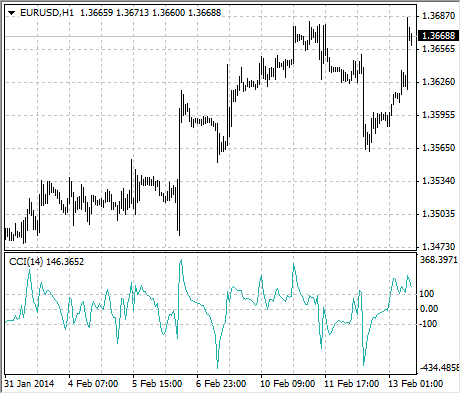MetaTrader 4 Help
- Accelerator/Decelerator Oscillator
- Accumulation/Distribution
- Alligator
- Average Directional Movement Index
- Average True Range
- Awesome Oscillator
- Bears Power
- Bollinger Bands
- Bulls Power
- Commodity Channel Index
- DeMarker
- Envelopes
- Force Index
- Fractals
- Gator Oscillator
- Ichimoku Kinko Hyo
- Market Facilitation Index
- Momentum
- Money Flow Index
- Moving Average
- Moving Average Convergence/Divergence
- Moving Average of Oscillator
- On Balance Volume
- Parabolic SAR
- Relative Strength Index
- Relative Vigor Index
- Standard Deviation
- Stochastic Oscillator
- Williams' Percent Range
Commodity Channel Index
Commodity Channel Index Technical Indicator (CCI) measures the deviation of the commodity price from its average statistical price. High values of the index point out that the price is unusually high being compared with the average one, and low values show that the price is too low. In spite of its name, the Commodity Channel Index can be applied for any financial instrument, and not only for the wares.
There are two basic techniques of using Commodity Channel Index:
- Finding the divergences
The divergence appears when the price reaches a new maximum, and Commodity Channel Index can not grow above the previous maximums. This classical divergence is normally followed by the price correction. - As an indicator of overbuying/overselling
Commodity Channel Index usually varies in the range of ±100. Values above +100 inform about overbuying state (and about a probability of correcting decay), and the values below 100 inform about the overselling state (and about a probability of correcting increase).

Calculation
- To find a Typical Price. You need to add the HIGH, the LOW, and the CLOSE prices of each bar and then divide the result by 3.
TP = (HIGH + LOW +CLOSE)/3
- To calculate the n-period Simple Moving Average of typical prices.
SMA(TP, N) = SUM[TP, N]/N
- To subtract the received SMA(TP, N) from Typical Prices.
D = TP – SMA(TP, N)
- To calculate the n-period Simple Moving Average of absolute D values.
SMA(D, N) = SUM[D, N]/N
- To multiply the received SMA(D, N) by 0,015.
M = SMA(D, N) * 0,015
- To divide M by D
CCI = M/D
Where:
SMA – Simple Moving Average;
N – number of periods, used for calculation.